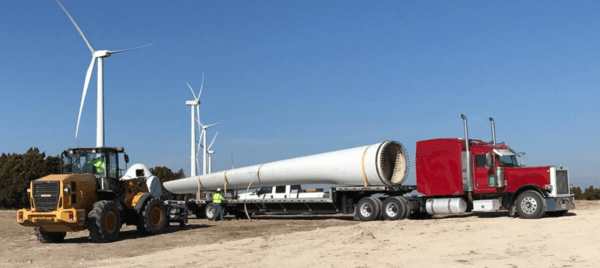News Release from GE Vernova
Wind Industry Profile of
Comeback Kids: This Company Gives Old Wind Turbine Blades A Second Life
Fenner is preparing to upgrade its blades, but the process created a new twist on the ages-old conundrum trailing progress: what to do with the obsolete technology. Crushing a blade yields about 15,000 pounds of fiberglass waste, and the process creates hazardous dust. Given that the blades are half the length of a football field, sending them to a landfill whole is out of the question.
That’s why Ronald Albrecht and Don Lilly of Global Fiberglass Solutions Inc. have come up with a better second act. Their Seattle-area-based company, which has been recycling fiberglass since 2008, invented a way to transform the old blades into products like manhole covers, building panels and pallets.

The blades are too large to haul to a landfill in one piece, and crushing them produces an unwieldy amount of fiberglass waste and hazardous dust. Global Fiberglass Solutions Inc. has developed a process for dismantling and recycling them instead. Images credit: GFSI.
The process begins at the wind farm itself, where technicians from GFSI cut dismantled blades into more manageable 37-meter chunks. Dust is the enemy. Unleashing tiny fiberglass particles into windy locations poses significant health hazards to animals and humans alike. To minimize — if not eliminate — dust, GFSI uses wet wire blades that are thin and strong enough to slice each wind blade open as cleanly as a cantaloupe. Then the company sprays a light mist of water so that debris rains into a giant dustpan lying beneath the blade.
Next, GFSI loads the dismantled blades onto enormous flatbed trucks and hauls them to nearby yards where the blades are shredded into raw fiberglass material known as feedback. A single blade yields about 15-20 bags of feedback weighing between 700 and 1,000 pounds each. GFSI will reuse 100 percent of each blade. Even the bolts that circle the blade’s end section go to a metal salvage site for recycling.
GFSI’s secret sauce is inside a formula that turns the crushed-up fiberglass into products like manhole covers, which are made of fiberglass mixed with rock and filler. As Albrecht, chief operating officer of GFSI, explains: “We had to figure out, ‘What is the percentage of wind turbine blade that goes into every individual product?”
For these complex chemical questions, GFSI turned to Dr. Karl Englund, a recycling expert at Washington State University’s Composite Materials and Engineering Center. ”So far, the products have performed extremely well,” Englund says. “The GFSI composite panels exceed wood-based composites in water resistance, mechanical properties, resistance to bio-deterioration and fire resistance.”
GE, which has been working with GFSI, can then buy back its old wind blades as new products. A single blade makes about 1,000 pallets that can be used for building walkways or vehicle flooring, and GFSI has recycled a total 564 blades for GE in less than a year. Based on current plans, GFSI estimates that GE could reuse 50 million pounds of waste in the next couple of years.
“The wind industry has matured significantly over the past 20 years,” says Deb Frodl, GE’s global executive director for Ecomagination. “So the ability to recycle wind blades is a great way to improve both environmental and operating performance.” At Fenner Wind Farm, annual energy production is expected to increase by nearly 23 percent. Thanks to the new blades.
GFSI customers could get a chance to recycle all of that waste once more. When the manhole covers, pallets and panels wear out in another 20 years, GFSI has plans to reuse the material for new products. Third-generation recycling could represent a new reality for industrial companies like GE, where businesses own the same resources — e.g., fiberglass materials — and repurpose them again and again. Not a bad afterlife for one of the forefathers of renewable energy.
- Source:
- GE Reports
- Author:
- Amy Kover
- Link:
- www.gereports.com/...
- Keywords:
- GE, recycling, repowering, wind farm


























